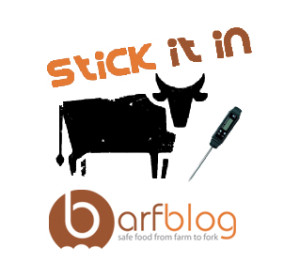The burden of foodborne diseases still represents a threat to public health; in 2012, the domestic setting accounted for 57.6% of strong-evidence EU food-borne Salmonella outbreaks. Next to cross-contamination, inadequate cooking procedure is considered as one of the most important factors contributing to food-borne illness.
 The few studies which have assessed the effect of domestic cooking on the presence and numbers of pathogens in different types of meat have shown that consumer-style cooking methods can allow bacteria to survive and that the probability of eating home-cooked poultry meat that still contains surviving bacteria after heating is higher than previously assumed. Thus, the main purpose of this study was to reproduce and assess the effect of several types of cooking treatments (according to label instructions and not following label instructions) on the presence and numbers of Salmonella Typhimurium DT 104 artificially inoculated in five types of poultry-based meat preparations (burgers, sausages, ready-to-cook-kebabs, quail roulades and extruded roulades) that are likely to be contaminated by Salmonella. Three contamination levels (10 cfu/g; 100 cfu/g and 1000 cfu/g) and three cooking techniques (grilling, frying and baking) were applied.
The few studies which have assessed the effect of domestic cooking on the presence and numbers of pathogens in different types of meat have shown that consumer-style cooking methods can allow bacteria to survive and that the probability of eating home-cooked poultry meat that still contains surviving bacteria after heating is higher than previously assumed. Thus, the main purpose of this study was to reproduce and assess the effect of several types of cooking treatments (according to label instructions and not following label instructions) on the presence and numbers of Salmonella Typhimurium DT 104 artificially inoculated in five types of poultry-based meat preparations (burgers, sausages, ready-to-cook-kebabs, quail roulades and extruded roulades) that are likely to be contaminated by Salmonella. Three contamination levels (10 cfu/g; 100 cfu/g and 1000 cfu/g) and three cooking techniques (grilling, frying and baking) were applied.
Cooking treatments performed according to label instructions eliminated Salmonella Typhimurium (absence per 25 g) for contamination levels of 10 and 100 cfu/g but not for contamination levels of 1000 cfu/g. After improper cooking, 26 out of 78 samples were Salmonella-positive, and 23 out of these 26 samples were artificially contaminated with bacterial loads between 100 and 1000 cfu/g. Nine out of 26 samples provided quantifiable results with a minimum level of 1.4 MPN/g in kebabs (initial inoculum level: 100 cfu/g) after grilling and a maximum level of 170 MPN/g recorded in sausages (initial inoculum level: 1000 cfu/g) after grilling.
Kebabs were the most common Salmonella-positive meat product after cooking, followed by sausages, burgers and extruded roulades; in relation to the type of cooking treatment applied, Salmonella Typhimurium was detected mostly after frying.
Thus, following label instructions mostly, but not always, produced safe cooked poultry-based meat preparations, while the application of inadequate cooking treatments was not able to assure complete elimination of Salmonella from the products even with a low contamination level (10 cfu/g). Consequently, there is a need to develop guidelines for producers and consumers and promote a multidisciplinary educational campaign in order to provide information on safe cooking and time-temperature combinations able to maintain the organoleptic qualities of meat.
International Journal of Food Microbiology, Volume 197, 16 March 2015, Pages 1–8
Anna Roccato, Mieke Uyttendaele, Veronica Cibin, Federica Barrucci, Veronica Cappa, Paola Zavagnin, Alessandra Longo, Antonia Ricci
http://www.sciencedirect.com/science/article/pii/S0168160514006011
